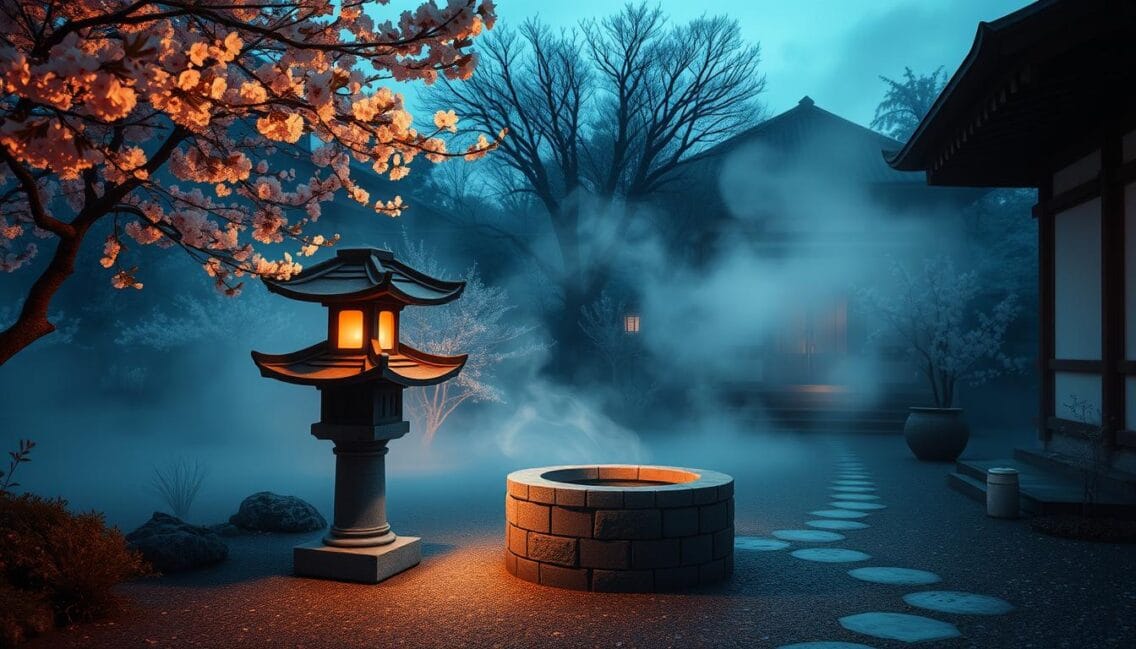The True Story of Okiku: Japan’s Ghost Legend

I’ve always been drawn to Japanese folklore, especially the tale of Okiku. Her story is one of Japan’s most famous ghost legends. I remember hearing about her ghostly wails and the mysteries of her death. Now, I’m excited to share her true story with you.
Okiku’s tale is more than just a ghost story. It’s a deep dive into Japanese culture, showing the traditions and beliefs that created this legend. From ancient folklore to her tragic fate, this article will explore the history behind Japan’s most haunting ghost story.
Key Takeaways
- Okiku’s story is a true historical legend that has captivated Japanese audiences for centuries
- The tale is rooted in the ancient folklore and cultural traditions of feudal Japan
- Okiku’s fate was shaped by the social dynamics and power structures of her time
- The legend has had a lasting impact on Japanese horror and supernatural storytelling
- Okiku’s ghostly presence continues to captivate visitors to the haunted Himeji Castle
Origins of the Haunting Tale in Japanese Culture
The story of Okiku, a vengeful Japanese spirit, is deeply rooted in Japanese folklore. It started in the feudal era, when samurai legend and the supernatural mixed. This created a cultural phenomenon that has lasted for centuries.
Ancient Folklore Roots in Feudal Japan
In the Edo period, Japan was ruled by the shoguns. During this time, Japanese folklore stories about vengeful spirits were very popular. These stories showed the violent and turbulent life of that era.
Historical Context of Ghost Stories in Japanese Society
The Okiku legend is connected to feudal Japan’s social and cultural norms. It deals with betrayal, loss, and seeking justice. These themes match the samurai code of honor and the unease in Japanese society back then.
Regional Variations of the Legend
Even though the Okiku story stays the same, it has different versions across Japan. These versions show the unique cultures and places they come from. They add to the rich Japanese folklore around this vengeful spirit.
True Story with Okiku, Japan: Historical Facts Behind the Legend
Exploring the true story with Okiku means looking into Japanese historical context. This helps us understand the legend better. The story of Okiku is well-known in Japan, but its real beginnings might surprise you.
Experts think the Okiku legend came from real events in the Edo period. This was a time of big changes in Japan. The story might be based on a young palace servant’s sad end.
Though details are unclear, these records offer a peek into the true story with Okiku. They show us the historical context that made this ghost story last.
The Tragic Life of Okiku: A Tale of Betrayal and Death
Okiku’s story is a sad chapter in Japan’s samurai legend. She was a castle servant, known for her loyalty and hard work. But her dedication led to her tragic end.
Okiku’s Role as a Castle Servant
Okiku spent her days helping the samurai lord. She made sure the castle ran smoothly and met her masters’ high standards. Her work earned her respect from everyone. But, her life was about to take a dark turn.
The Missing Plate Incident
The event that turned Okiku into a vengeful spirit was the theft of a porcelain plate. She was wrongly accused and couldn’t clear her name. This betrayal broke her spirit.
The Fatal Consequences
Okiku faced a cruel punishment for the missing plate. Her death was a gruesome fate that haunts the samurai legend. Her story warns of the dangers of broken trust and the harsh outcomes of betrayal.
Himeji Castle: The Setting of Okiku’s Story
Himeji Castle is in the heart of Japan, a symbol of the country’s history and culture. Its white facade and detailed design make it famous. It’s the setting for Okiku’s story, a cursed object that fascinates people worldwide.
Walking through the castle, I feel Okiku’s paranormal activity around me. The tale says Okiku, a castle worker, was killed here. Now, her spirit looks for the missing plate that caused her death.
Himeji Castle’s history is as intriguing as the ghost story tied to it. Built in the 14th century, it was a key stronghold in Japan’s feudal era. Now, it’s a UNESCO World Heritage Site, attracting tourists interested in history and the paranormal activity it’s said to have.
The Haunted Well: Where Legend Meets Reality
Deep in Himeji Castle’s historic walls is a mysterious relic – Okiku’s Well. It’s a place of legend for those who seek the truth about paranormal activity and spiritual vengeance. The well is tied to a tragic tale of a young castle servant.
Physical Description of Okiku’s Well
Going down into the well, you feel the heavy weight of history. The walls show signs of time, with scars from centuries past. The top’s narrow opening casts a dark shadow, hinting at a cursed object below.
Reported Paranormal Activities
People visiting Okiku’s Well often hear strange sounds, like a woman’s voice. They also feel like they’re being watched. Some see a ghostly young woman, her face hidden, standing at the well’s edge.
Modern-Day Visitor Experiences
Today, Okiku’s Well attracts ghost hunters and paranormal fans. They hope to experience the paranormal activity firsthand. Some return with scary stories, while others gain a new respect for the spiritual vengeance here.
Evolution of Okiku’s Ghost in Popular Culture
The story of Okiku, a tragic figure from Japanese folklore, has spread worldwide. It has become a global phenomenon. Over the years, this haunted doll legend has evolved, captivating audiences in many ways.
From its roots in *Japanese folklore* to its modern adaptations, Okiku’s tale has fascinated many. The idea of a *haunted doll* inspired by Okiku has become a key part of *cultural superstition* and horror stories globally.
Okiku’s story has been retold in literature, theater, and film. Each version adds new depth and complexity. Her ghostly presence, relentless pursuit of justice, and eerie atmosphere make her a standout in *Japanese folklore*.
The world remains captivated by Okiku’s haunting tale. The evolution of this *haunted doll* legend shows the lasting power of storytelling. It also highlights the eternal fascination with the supernatural in human culture.
The Vengeful Spirit: Understanding Japanese Ghost Classifications
Exploring Japanese folklore, I find myself captivated by the world of _vengeful spirits_. These spirits have a special place in the culture. We’ll look into _yurei_, the traditional Japanese ghost, and the enchanting female ghost stories that have fascinated people for ages.
Yurei Traditions in Japanese Folklore
The _yurei_ is at the core of Japanese ghost stories. These spirits, born from untimely or unfair deaths, stay in the world of the living. They seek _spiritual vengeance_ for their unfinished lives. The _yurei_ shows Japan’s deep respect for the afterlife and the supernatural.
Characteristics of Female Ghost Stories
Female _yurei_ have always fascinated the Japanese. Their tales often revolve around betrayal, unfulfilled love, and the harsh effects of social oppression. These _vengeful spirits_ are seen as beautiful but tragic. They remind us of the injustices they faced in life. Figures like _Okiku_ and _Oiwa_ have made a lasting impact on Japanese folklore and continue to inspire today.
Modern Interpretations and Adaptations of Okiku’s Story
The *true story with Okiku*, Japan’s legendary ghost, has fascinated people for centuries. Modern storytellers have taken on this tale, giving it new life in creative ways. They’ve reimagined Okiku’s story, making it fresh and thought-provoking.
The *Okiku’s Lament* short film is a great example. It mixes historical and supernatural elements, showing Okiku’s haunting side. The film’s visuals and sound are haunting, leaving viewers with a lasting scare.
Authors have also put their spin on Okiku’s legend. *Okiku’s Tale*, a hit novel, tells the story through a paranormal investigator’s eyes. It combines history with fiction, drawing readers into Okiku’s world.
These new takes on Okiku’s story show her legend’s lasting power. By adding fresh perspectives, storytellers keep Okiku’s haunting alive. Her tale will continue to thrill and chill people for years to come.
Impact on Japanese Horror Genre and Global Ghost Stories
Okiku’s haunting tale has captivated Japanese audiences for centuries. Her story has deeply influenced Japan’s horror genre. The eerie presence of Okiku’s vengeful spirit has inspired many works of literature and cinema.
Influence on Literature and Cinema
Okiku’s legend has inspired writers and filmmakers worldwide. Her tale of betrayal and anguish has been reimagined in many forms. Each version adds a unique twist to the haunting narrative.
Her ghostly wail and lifeless body are iconic in Japanese horror. These elements have captivated audiences both at home and abroad.
Cultural Exchange and Western Adaptations
Okiku’s tale has crossed cultural boundaries, sparking a global exchange. Western audiences have been drawn to the themes of vengeance, betrayal, and the supernatural. Her story has been adapted in literature and Hollywood, showing the power of cultural superstition.
FAQ
What is the true story behind the legend of Okiku in Japan?
The legend of Okiku is a famous ghost story in Japan. It’s based on the country’s rich culture and beliefs in the supernatural. Okiku was a servant at Himeji Castle during feudal times.
The story tells of her tragic death and how she became a vengeful spirit. She haunts the castle and the well where she died.
What is the historical context of the Okiku legend in Japanese culture?
The Okiku legend comes from ancient Japanese folklore. It shows the values and customs of the samurai class. Themes like honor, loyalty, and betrayal are central to the story.
The legend has spread across Japan, showing its wide influence.
What are the documented historical facts behind the Okiku legend?
The Okiku legend has both supernatural and historical parts. Researchers have found facts that support the story. This helps separate fact from fiction, giving a clearer view of the legend’s origins.
What is the tragic life story of Okiku, the central figure of the legend?
Okiku was a castle servant who met a tragic end. She was wrongly accused of losing a valuable plate. This led to her brutal murder by a samurai lord.
Her death turned her into a vengeful spirit. She haunts the castle, seeking justice for her unjust death.
What is the significance of Himeji Castle in the Okiku legend?
Himeji Castle is the setting for the Okiku legend. Its architecture and history are linked to the ghost story. Visitors can explore the castle and the well where Okiku is said to reside.
What are the reported paranormal activities associated with Okiku’s well?
Okiku’s well is a hotspot for ghost hunters and tourists. They report strange sounds and sightings of a ghostly figure. Visitors often feel a sense of unease, adding to the legend’s mystique.
How has the Okiku legend evolved in popular culture?
The Okiku story has captivated audiences for centuries. It has been adapted in literature, theater, and film. The legend has inspired the “haunted doll” trope in horror genres.
Its lasting popularity shows the impact of Japanese folklore on culture.
How does the Okiku legend fit into the broader classification of Japanese ghosts and spirits?
The Okiku legend is part of Japanese folklore’s vengeful spirits, or yurei. Okiku’s story is typical of female ghost tales. It shows the cultural beliefs about spiritual vengeance and the afterlife.
How have modern interpretations and adaptations of the Okiku legend impacted its legacy?
Modern storytellers have reimagined the Okiku legend. They’ve added elements of paranormal investigation and psychological horror. These updates keep the story relevant and explore themes of betrayal and injustice.
The Okiku legend’s continued relevance shows its lasting impact on Japanese horror and global ghost stories.



